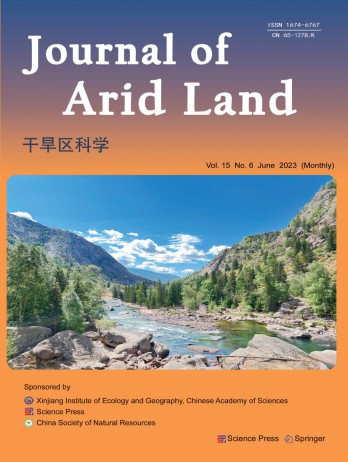
Journal of Arid Land雜志 CSCD期刊統(tǒng)計源期刊SCI期刊
中國科學(xué)院
2009
中國科學(xué)院新疆生態(tài)與地理...
1674-6767
830011
65-1278/K
英語
陳曦,李百煉
2-419
200
Journal of Arid Land雜志簡介
《Journal of Arid Land》(簡稱JAL)是中國科學(xué)院新疆生態(tài)與地理研究所和科學(xué)出版社聯(lián)合主辦、科學(xué)出版社出版的自然科學(xué)綜合性學(xué)術(shù)季刊。
《JournalofAridLand》刊登干旱和半干旱地區(qū)水、土、生物、氣候等自然資源變化及其大氣圈、水圈、生物圈、巖石圈之間的相互作用和與人類活動的關(guān)系,干旱和半干旱地區(qū)地理、生態(tài)和環(huán)境格局及生態(tài)建設(shè)和環(huán)境保護,干旱和半干旱區(qū)域?qū)θ蜃兓捻憫?yīng)與反饋機制等原創(chuàng)性、綜合性、理論性和實用性的研究成果.
《Journal of Arid Land》本刊還開展中亞地區(qū)資源環(huán)境、生態(tài)安全及區(qū)域可持續(xù)發(fā)展的國際學(xué)術(shù)交流;同時刊登上述方面的研究評述、快訊、學(xué)術(shù)動態(tài)及本領(lǐng)域重要參考書書評等。本刊主要設(shè)有學(xué)術(shù)論文、專題評述、研究簡訊、學(xué)術(shù)動態(tài)、書評等五個欄目,以國內(nèi)外從事干旱區(qū)自然地理、生物、土壤/土地資源、環(huán)境、氣候、水文水資源、社會科學(xué)等方面研究的專家學(xué)者,以及這些領(lǐng)域教學(xué)和學(xué)習(xí)的大專院校的教師和學(xué)生為讀者對象。
《Journal of Arid Land》于2009年第四季度創(chuàng)刊,目前,在國際上被俄羅斯《文摘雜志》(AJ)VINITI數(shù)據(jù)庫、波蘭《哥白尼索引》(Indexof Copernicus,IC)和美國《烏利希期刊指南》(Ulrich’s Periodicals Directory)收錄,在國內(nèi)被《中國核心期刊(遴選)數(shù)據(jù)庫》、《中國學(xué)術(shù)期刊網(wǎng)絡(luò)出版總庫》收錄,并在《中國科技期刊網(wǎng)》、《中國科學(xué)院科技期刊開放獲取平臺》、《干旱區(qū)科學(xué)》域名網(wǎng)站等網(wǎng)絡(luò)平臺上全文。
Journal of Arid Land發(fā)文方向
學(xué)術(shù)論文、專題評述、研究簡訊、學(xué)術(shù)動態(tài)、書評
Journal of Arid Land雜志特色
Keywords: Immediately after the abstract, provide 3 to 7 keywords, closely related to the subject of the article. Avoid general and plural terms and multiple concepts (e.g., 'and', 'of').
Introduction: Provide an adequate background. State the significance, objective and method of the research, citing necessary references, especially references of work published in the last two to three years.
Study area/materials and methods: Introducing a general idea of the study area or experimental setting, the materials and methods used and the basic progress of the study. Provide sufficient detail to allow the work to be reproduced or substantiated.
Methods already published should be indicated by a reference.
Results: Relating the findings and results of the observation(s) and experiment(s) without interpreting their meaning. Results should be clear and concise.
Discussion: Explaining all of your observations within your experiment(s). Exploring the significance of the results, but do not repeat them in the text. Stating whether each of your hypotheses are supported, rejected or if you cannot make a decision with confidence, and suggesting future studies or modifications to the same study.
Conclusions: Presenting main conclusions of the study that may stand alone or creating a discussion subsection.
Acknowledgements: Acknowledgements should include, if applicable, information on grants received, funding organizations, and/or recognition of people who assisted in the research or article.
References: Please cite a reference to acknowledge sources of information from others’ research and results. Ensure that
every reference cited in the text is also present in the reference list. Citation guidelines are as follows: as (Smith, 1998) for single author, as (Smith and Miller, 1999) for two authors, and as (Smith et al., 2006) for three or more authors. Groups of references should be listed first chronologically, then alphabetically. In the reference list, references should be arranged first alphabetically, then chronologically, if necessary. More than one reference from the same author(s) in the same year must be identified by the letters "a", "b", "c", etc., placed after the year of publication. Journal names should not be abbreviated.
Reference examples:
Articles: Ames R N, Reid C P P, Porter L K, et al. 1983. Hyphal uptake and transport of nitrogen from two 15N-labelled
sources by Glomus misseae, a vesicular-arbuscular mycorrhizal fungus. New Phytologist, 95(3): 381?396.
Monograph: Lambers H, Stuart Chapin ΙΙΙ F, Pons T L. 2008. Plant Physiological Ecology. 2nd ed. New York: Springer Science+Business Media, 56?64.
Proceedings: Bernstein N, Kafkafi U. 2002. Root growth under salinity stress. In: Waisel Y, Eshel A, Kafkafi U. Plant Roots,
the Hidden Half. New York: Marcel Dekker Press, 787?805.
Electronic reference: UNESCO World Heritage Centre. 2008. Operational Guidelines for the Implementation of the World
Heritage Convention. Paris: UNESCO World Heritage Centre. [2009-11-17].
雜志收錄與榮譽
Journal of Arid Land雜志數(shù)據(jù)統(tǒng)計注:由于版面限制,此處僅列出部分?jǐn)?shù)據(jù)信息,了解詳情請聯(lián)系客服 了解詳情 >>
年度期刊評價報告 (本刊綜合數(shù)據(jù)對比及走勢)
名詞解釋:
影響因子:指該期刊近兩年文獻的平均被引用率,即該期刊前兩年論文在評價當(dāng)年每篇論文被引用的平均次數(shù)
被引半衰期:衡量期刊老化速度快慢的一種指標(biāo),指某一期刊論文在某年被引用的全部次數(shù)中,較新的一半被引論文刊載的時間跨度
期刊他引率:他引率是指,此期刊被引用次數(shù)中,被其他刊引用次數(shù)所占的比例
引用半衰期:指某種期刊在某年中所引用的全部參考文獻中較新的一半是在最近多少年時段內(nèi)刊載的
平均引文率:在給定的時間內(nèi),期刊篇均參考文獻量,用以測度期刊的平均引文水平,考察期刊吸收信息的能力以及科學(xué)交流程度的高低
雜志被引半衰期、引用半衰期
雜志影響因子、被引次數(shù)
雜志發(fā)文量、期刊他引率
雜志平均引文率
我們提供的服務(wù)
在線客服
一對一咨詢服務(wù)、簡單快捷、省時省力
了解更多 >快遞配送
直郵到家、實時跟蹤、更安全更省心
了解更多 >雜志訂閱
去除中間環(huán)節(jié)享受低價,物流進度實時通知
了解更多 >雜志推薦
正版雜志,匹配度高、性價比高、成功率高
了解更多 >期刊導(dǎo)航
相關(guān)標(biāo)簽:
基礎(chǔ)科學(xué)綜合 自然科學(xué)理論與方法 數(shù)學(xué) 非線性科學(xué)與系統(tǒng)科學(xué) 力學(xué) 物理學(xué) 生物學(xué) 天文學(xué) 自然地理學(xué)測繪學(xué) 氣象學(xué) 海洋學(xué) 地質(zhì)學(xué) 地球物理學(xué) 資源科學(xué)
期刊收錄:
CSCD期刊統(tǒng)計源期刊SCI期刊CSCD 中國科學(xué)引文數(shù)據(jù)庫來源期刊(含擴展版)統(tǒng)計源期刊(中國科技論文優(yōu)秀期刊)知網(wǎng)收錄(中)維普收錄(中)萬方收錄(中)SCI 科學(xué)引文索引(美)Pж(AJ) 文摘雜志(俄)哥白尼索引(波蘭)劍橋科學(xué)文摘國家圖書館館藏上海圖書館館藏文摘與引文數(shù)據(jù)庫文摘雜志
常見問題
相關(guān)期刊
- Chinese Medical Journal
- Journal of Environmental Sciences
- Journal of Energy Chemistry
- Chinese Journal of Integrative Medicine
- Chinese Journal of Chemistry
- Asian Journal of Andrology
- Journal of Integrative Plant Biology
- Journal of Computer Science and Technology
- Chinese Journal of Mechanical Engineering
- Chinese Journal of Aeronautics
免責(zé)聲明
若用戶需要出版服務(wù),請聯(lián)系出版商,地址:新疆烏魯木齊市北京南路818號,郵編:830011。